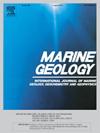Distinct sandbar behavior on a gently sloping shoreface sea-breeze dominated beach
IF 2.2
3区 地球科学
Q2 GEOSCIENCES, MULTIDISCIPLINARY
引用次数: 0
Abstract
Sandbars are common features in sandy nearshore environments that readily migrate in response to changing hydrodynamic conditions and, when in shallow water, can provide coastal protection by inducing wave breaking and through sediment feeding to the beach. Prior process-based studies related the off- (on-) shore sandbar migration with the increase of the undertow current (wave acceleration skewness) associated to storm (mild) conditions. However, onshore sandbar migration has, under some circumstances, also been reported to occur during storms at mild sloping shorefaces. A comprehensive 9-year data set of (200) weekly to bi-weekly surveys of the beach and shallow nearshore, undertaken on an accretive micro-tidal sea-breeze dominated beach along the southeastern coast of Mexico, are presented here that shed new insights into hydrodynamic drivers of inner surf zone sandbar and shoreline dynamics. During spring-summer, short period waves, mainly associated to local sea-breezes, drive offshore sandbar migration. On the other hand, winter storms, occurring during fall-winter months, generate more energetic swell waves that induce onshore sandbar migration. In general, seasonal changes of shoreline and inner sandbar position are coupled, with on- (off-) shore sandbar migration being synchronous to seasonal shoreline advance (retreat), suggesting a gradual feeding of sediment from the bar system onto the beach. Analysis of the data, in conjunction with comparison to equilibrium model results, are used to explore the physical drivers of sub-seasonal sandbar evolution at the site. The sandbar dynamics in the study area, showing an opposite behavior to conventional expectation of storm-induced offshore transport, are well correlated to seasonal changes of waves properties. This distinct sandbar behavior might be present at other gently sloping shoreface sea-breeze dominated sandy beaches.
在平缓倾斜的海岸表面上有明显的沙洲特征,海风主导着海滩
沙洲是沙质近岸环境中的常见特征,它们很容易随着水动力条件的变化而迁移,在浅水中,它们可以通过诱导波浪破碎和沉积物进入海滩来提供海岸保护。先前基于过程的研究将离岸(岸上)沙洲迁移与与风暴(温和)条件相关的暗流(波加速度偏度)的增加联系起来。然而,据报道,在某些情况下,在温和倾斜的海岸表面发生风暴时,陆上沙洲也会迁移。在墨西哥东南海岸的微潮汐海风主导的海滩上进行了为期9年的(200)周至双周的海滩和浅近岸调查的综合数据集,在这里提出了对内冲浪带沙洲和海岸线动力学的流体动力驱动的新见解。在春夏季,短周期波浪主要与局地海风有关,推动近海沙洲迁移。另一方面,在秋冬季节发生的冬季风暴会产生更强的涌浪,导致岸上沙洲的迁移。总的来说,岸线和内沙洲位置的季节变化是耦合的,岸上(离岸)沙洲的迁移与海岸的季节性推进(后退)是同步的,表明泥沙从沙洲系统逐渐进入海滩。对这些数据进行分析,并与平衡模式的结果进行比较,探讨了该站点亚季节沙洲演变的物理驱动因素。研究区域的沙洲动力学表现出与传统的风暴诱发离岸运输相反的行为,与波浪性质的季节性变化密切相关。这种独特的沙洲行为可能出现在其他缓倾斜的滨面海风主导的沙滩上。
本文章由计算机程序翻译,如有差异,请以英文原文为准。
求助全文
约1分钟内获得全文
求助全文
来源期刊

Marine Geology
地学-地球科学综合
CiteScore
6.10
自引率
6.90%
发文量
175
审稿时长
21.9 weeks
期刊介绍:
Marine Geology is the premier international journal on marine geological processes in the broadest sense. We seek papers that are comprehensive, interdisciplinary and synthetic that will be lasting contributions to the field. Although most papers are based on regional studies, they must demonstrate new findings of international significance. We accept papers on subjects as diverse as seafloor hydrothermal systems, beach dynamics, early diagenesis, microbiological studies in sediments, palaeoclimate studies and geophysical studies of the seabed. We encourage papers that address emerging new fields, for example the influence of anthropogenic processes on coastal/marine geology and coastal/marine geoarchaeology. We insist that the papers are concerned with the marine realm and that they deal with geology: with rocks, sediments, and physical and chemical processes affecting them. Papers should address scientific hypotheses: highly descriptive data compilations or papers that deal only with marine management and risk assessment should be submitted to other journals. Papers on laboratory or modelling studies must demonstrate direct relevance to marine processes or deposits. The primary criteria for acceptance of papers is that the science is of high quality, novel, significant, and of broad international interest.
 求助内容:
求助内容: 应助结果提醒方式:
应助结果提醒方式:


